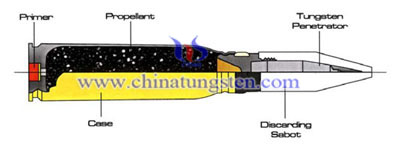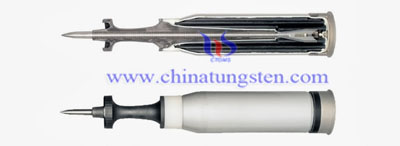
The sub-projectile of the tungsten alloy Armour-piercing discarding sabot (APDS consists of a tungsten alloy high density core with a penetrating cap, enclosed within a high strength sheath (steel) with a lightweight alloy (aluminum-magnesium alloy) ballistic cap. For modern small/medium calibre APDS projectiles, the core is not sheathed and the ballistic and penetrating caps are combined. A tracer element may be added to the APDS sub-projectile, for large calibre weapons this is part of the outer sheath, for small/medium calibre weapons it is contained within a hollow cavity in, or attached to, the base of the core. Most modern APDS projectiles used high strength shock resistant tungsten alloys. The main constituent is tungsten, alloyed or sintered with/to cobalt, copper, iron or nickel.

When a large calibre APDS is fired and while still within the bore, the setback forces shear the forward petals, partly unlocking the sub-projectile from the sabot, but still holding it rigidly within the pot. Gas pressure is used to delay the unlocking of the pins holding the rear part of the sub-projectile by gyroscopic forces. Once outside the barrel, the pins, centering band and forward petals are released or discarded by projectile spin, the aerodynamic drag removes the pot/base unit. As an APDS sub-projectile does not require driving bands and the core is supported at the base and ogive region, a far more aerodynamic projectile shape can be chosen. This, in combination with the sub-projectiles’ higher sectional density, gives the resulting sub-projectile vastly reduced aerodynamic drag in comparison to the APCR
To allow increased impact velocity, a stronger penetrator material was required. The chosen new penetrator material was tungsten alloy(WHA), due to its greater strength and its ability to withstand the greater shock and pressure generated during a higher velocity impact. As the density of WHA is twice that of steel, such a shot was too heavy at full bore to be accelerated to a sufficient muzzle velocity.

if you have any interest in tungsten alloy armor piercing, please feel free to contact us by email: sales@chinatungsten.com or by phone: 86 592 5129696.